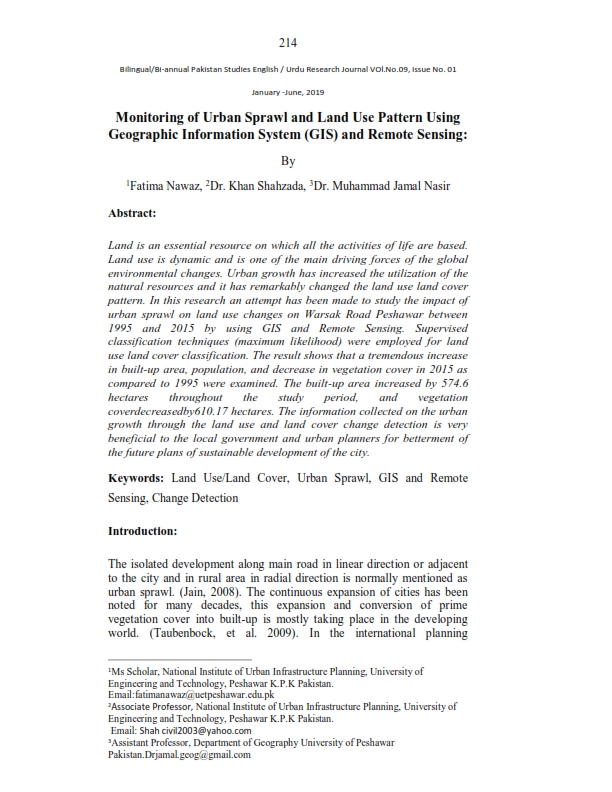Monitoring of Urban Sprawl and Land Use Pattern Using Geographic Information System (GIS) and Remote Sensing
Keywords:
Land Use/Land Cover, Urban Sprawl, GIS and Remote Sensing, Change DetectionAbstract
Land is an essential resource on which all the activities of life are based.
Land use is dynamic and is one of the main driving forces of the global
environmental changes. Urban growth has increased the utilization of the
natural resources and it has remarkably changed the land use land cover
pattern. In this research an attempt has been made to study the impact of
urban sprawl on land use changes on Warsak Road Peshawar between
1995 and 2015 by using GIS and Remote Sensing. Supervised
classification techniques (maximum likelihood) were employed for land
use land cover classification. The result shows that a tremendous increase
in built-up area, population, and decrease in vegetation cover in 2015 as
compared to 1995 were examined. The built-up area increased by 574.6
hectares throughout the study period, and vegetation
coverdecreasedby610.17 hectares. The information collected on the urban
growth through the land use and land cover change detection is very
beneficial to the local government and urban planners for betterment of
the future plans of sustainable development of the city.
References
Jain, M. (2008). GIS and Remote Sensing Applications to Study Urban
Sprawl of Udaipur. India, Mohan LalSukhadia University,
Udaipur, Raj., India.
Taubenböck, H., Wegmann, M., Roth, A., Mehl, H., &Dech, S. (2009).
Urbanization in India–Spatiotemporal analysis using remote
sensing data. Computers, Environment and Urban Systems, 33(3),
-188.
Siedentop, S., & Fina, S. (2010). Monitoring urban sprawl in Germany:
towards a GIS-based measurement and assessment
approach. Journal of Land Use Science, 5(2), 73-104.
Jensen, J. R. (2004). Digital change detection. Introductory digital image
processing: A remote sensing perspective, 467-494.
Epstein, J., Payne, K., & Kramer, E. (2002). Techniques for mapping
suburban sprawl. Photogrammetric engineering and remote
sensing, 68(9), 913-918.
Kaya, S., & Curran, P. J. (2006). Monitoring urban growth on the
European side of the Istanbul metropolitan area: A case
study. International Journal of Applied Earth Observation and
Geoinformation, 8(1), 18-25.
Weng, Q. (2001). A remote sensing? GIS evaluation of urban expansion
and its impact on surface temperature in the Zhujiang Delta,
China. International journal of remote sensing, 22(10), 1999-2014.
Minallah, m., rafique, m., anwar, m., & mohsin, m. (2016). Assessing the
Urban Growth and Morphological Patterns of Gojra City,
Pakistan. Sindh University Research Journal-SURJ (Science
Series), 48(2).
Al-shalabi, M., Billa, L., Pradhan, B., Mansor, S., & Al-Sharif, A. A.
(2013). Modelling urban growth evolution and land-use changes
using GIS based cellular automata and SLEUTH models: the case
of Sana’a metropolitan city, Yemen. Environmental earth
sciences, 70(1), 425-437.
Weng, Y. C. (2007). Spatiotemporal changes of landscape pattern in
response to urbanization. Landscape and urban planning, 81(4),
-353.
Dadras, M., MohdShafri, H. Z., Ahmad, N., Pradhan, B., &Safarpour, S.
(2014). Land use/cover change detection and urban sprawl analysis
in Bandar Abbas City, Iran. The Scientific World Journal, 2014.
Hoymann, J. (2011). Accelerating urban sprawl in depopulating regions: a
scenario analysis for the Elbe River Basin. Regional
Environmental Change, 11(1), 73-86.
Ndukwe, N. K. (1997). Principles of environmental remote sensing and
photo Interpretation.New Concept Publishers.
Baulies, X., &Szejwach, G. (Eds.). (1998). LUCC Data Requirements
Workshop: Survey of Needs, Gaps and Priorities on Data for
Land-use/land-cover Change Research: Barcelona, 11-14
November 1997. InstitutCartogràfic de Catalunya.
Samiullah, S. (2013). Expansion of built up area and its impact on urban
agriculture: a case study of Peshawar Pakistan (Doctoral
dissertation, University of Peshawar, Peshawar).
Saleh, B., & Al Rawashdeh, S. (2007). Study of urban expansion in
jordanian cities using GIS and remoth Sensing. International
Journal of Applied Science and Engineering, 5(1), 41-52.
Barnes, K. B., Morgan III, J. M., Roberge, M. C., & Lowe, S. (2001).
Sprawl development: its patterns, consequences, and
measurement. Towson University, Towson, 1-24.
Campbell, J. B., & Wynne, R. H. (2011). Introduction to remote sensing.
Guilford Press.
Rwanga, S. S., &Ndambuki, J. M. (2017). Accuracy Assessment of Land
Use/Land Cover Classification Using Remote Sensing and
GIS. International Journal of Geosciences, 8(04), 611.



